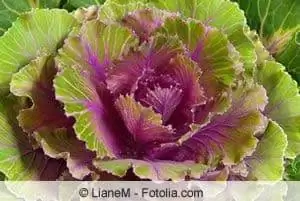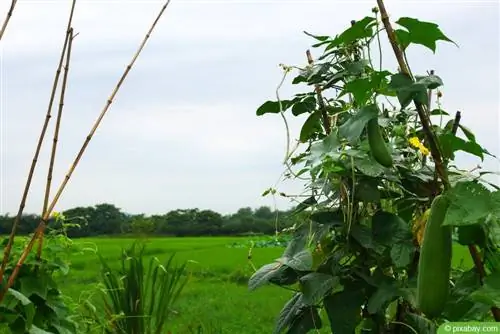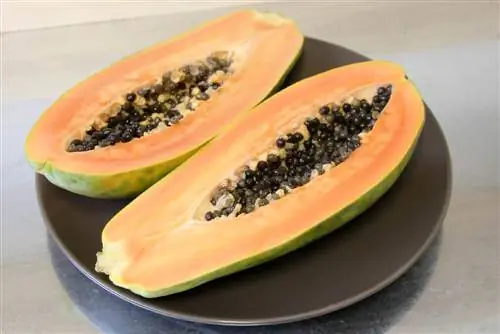- Author admin [email protected].
- Public 2023-12-17 03:39.
- Last modified 2025-01-24 12:45.
The ornamental cabbage is closely related to the kale. Most varieties of this colorful relative were bred in Japan. The Japanese seem to have a special feeling for transforming nature's specifications into small works of art through human hands. Every year there are new varieties on the market. With a little effort, you can easily grow ornamental cabbage yourself. Anyone who sows in spring can enjoy colorful arrangements in pots, window boxes or borders towards the end of the year.
Sowing
You can take your time sowing. The seeds are only planted outdoors when it is definitely frost-free, around mid-May. In a greenhouse or cold frame you can start earlier. The best germination temperature is 15 to 20°C. It then takes 10 to 20 days for the seedlings to emerge into daylight. You can sow ornamental cabbage until mid-July. However, the later you start sowing, the fewer leaves and flowers the cabbage will produce later. The seeds are first placed in nutrient-poor soil, either in cultivation containers or directly outdoors. Then covered with soil, about twice the size of the seed. Now just carefully, using the shower attachment, keep the seeds moist until they germinate. Once the seedlings have developed the first two real leaves, they are pricked out. Before you put the individual plants in small pots, you can shorten the main root a little. This provokes the development of many lateral roots. Only when the plant has developed up to six leaves does it go outdoors. All the time it is important that the young plants can capture enough light from all sides.
Planting
The plants are planted outdoors between May and August. You can also buy pre-grown young plants in stores. The pricked plants, or the purchased young plants, are then placed in nutrient-rich soil at a distance of approx. 25 cm from each other. When they reach a height of 20 cm, start removing the lower leaves from time to time. This is how the long-stemmed ornamental cabbage varieties get the desired stem length.

Location
Light is important, not just for the young plants. A sunny location protected from the weather is optimal. The sunnier the location, the stronger the leaf color will be in autumn. The ornamental cabbage reaches its most beautiful and intense color from September onwards. It requires temperatures below 15°C. As with most vegetables that belong to the cruciferous family and are therefore heavy eaters, it is also advisable to follow a crop rotation for ornamental cabbage. This means that it should only be grown again in the same location after a break of at least three years. This strengthens resistance and limits the emergence of pests.
Tip:
The neighboring plants also play a role for the ornamental cabbage. Good neighbors include legumes and nightshades. Rather than welcome in the neighborhood are, among other cruciferous vegetables, leeks and strawberries.
Floor
Like all types of cabbage, ornamental cabbage is also a heavy eater. That's why you enrich the soil with well-rotted compost or manure before planting it outdoors. A standard potting soil is sufficient for the pot. It is important to ensure good drainage in the bucket. The ornamental cabbage does not like waterlogging. The ornamental cabbage copes very well with the following soil properties:
- humic, nutrient-rich
- medium difficulty
- sandy-loamy, loamy, sandy-clayey, loamy-clayey
- slightly alkaline to slightly acidic

Care, watering, fertilizing
The ornamental cabbage only reaches its peak performance after it has bloomed in summer. Only when the temperatures are below 15°C, and later below 10°C, does it develop its full splendor of colour. Until then, it's important to keep him happy. It needs regular watering, but is sensitive to waterlogging. It responds to dry times with withered leaves. In summer you can fertilize every 14 days. A nitrogen-based fertilizer promotes an intense coloring of the leaves. As a rule, it is sufficient to mix the garden soil with well-rotted compost; in the summer you add organic fertilizer such as horn shavings, horn meal or castor meal. You can also use tomato fertilizer for the ornamental cabbage in the pot; it has the optimal nutrient composition. From August onwards there is no longer any need to fertilize. Too much nitrogen would now have a negative effect on leaf color. If you would like to benefit from the seeds after flowering in spring, you must ensure that the ornamental cabbage is adequately overwintered. It cannot tolerate long-term temperatures below -8°C. Container plants can be moved to cool winter storage when there is frost. Covers in the bed can protect against hard frosts. Watering must also be carried out during frost-free periods. An ornamental cabbage cared for in this way can then bloom and produce seeds next year.
Propagation
If the frosts in winter are not too severe or the ornamental cabbage is protected, they will survive the winter and produce yellow flowers in spring. The seeds can then be obtained from this. However, flowering with appropriate seeds next year is not always guaranteed. If you want to be on the safe side, buy the seeds and start growing the new ornamental cabbage plants early. Recommended varieties include King Red, King White, Red & White Peacock or Negro Romano. The ornamental cabbage from the previous year ends up in the compost after the winter. The new seeds are sown elsewhere according to the crop rotation.
Harvest
You can harvest after the first light frosts at the end of autumn or the beginning of winter. The foliage is now beautifully colored. Anyone who has planted the ornamental cabbage themselves can also prepare it in the kitchen without hesitation. However, it loses its beautiful colors when cooked. The edible, raw decorative leaves also make a good decoration for buffets, dishes and salad plates. The ornamental cabbage varieties with stems are ideal for winter flower arrangements.
Tip:
If the cabbage sits in the vase for some time, it can give off an unpleasant, coaly-rotten smell. It helps to change the water in the vase frequently and keep it clean.
Diseases Pests
Aphids
Aphids are probably the most widespread pests that attack our crops. They don't stop at ornamental cabbage either. The options for combating measures are correspondingly wide-ranging:
- cum with a sharp jet of water
- spray with: tobacco decoction, nettle decoction
- Predators: ladybirds, lacewings, parasitic wasps
Tip:
A soft soap mixture is not recommended for ornamental cabbage because the surfactants can leave ugly stains on the leaves.

cabbage white butterfly
If only the bare leaf veins of the ornamental cabbage can be seen, it is usually too late for control measures. It's best to check the undersides of the leaves every now and then for the eggs when the white butterflies appear frequently in summer. Destroy these yellowish eggs immediately. If necessary, collect caterpillars that have already hatched.
Carbon beetle beetles
The coal fleas cannot be recognized at first glance. Only when you look closely can you see small, black beetles with light stripes on the sides, jumping around near the ground. They leave lots of small holes on the leaves. They like dry soil. A well-loosened, moist and weed-free soil can make it uncomfortable for cabbage beetles. Effective chemical agents against coal fleas are not approved for private use.
Clubroot hernia
Clubroot is a dangerous fungal disease. When infested, the plants wilt and wither. The infestation itself can be recognized by knotty growths on the roots. So usually too late. A good precaution is to strictly adhere to crop rotation. If infested, wait another three years longer before replanting from the cruciferous family. Warm, moist and rather acidic soil as well as manure fertilization promote the development of clubroot.
Conclusion
When the summer blooms come to an end, the hour of ornamental cabbage strikes. Beautiful leaf shapes and colors then decorate gardens and terraces. In addition, it offers versatile uses, from vase to pot. In order to be able to benefit from ornamental cabbage in culinary terms, it is advisable to grow your own (organic) cabbage. Commercially available ornamental cabbage plants are mostly chemically treated and are better used only as ornamental plants.






